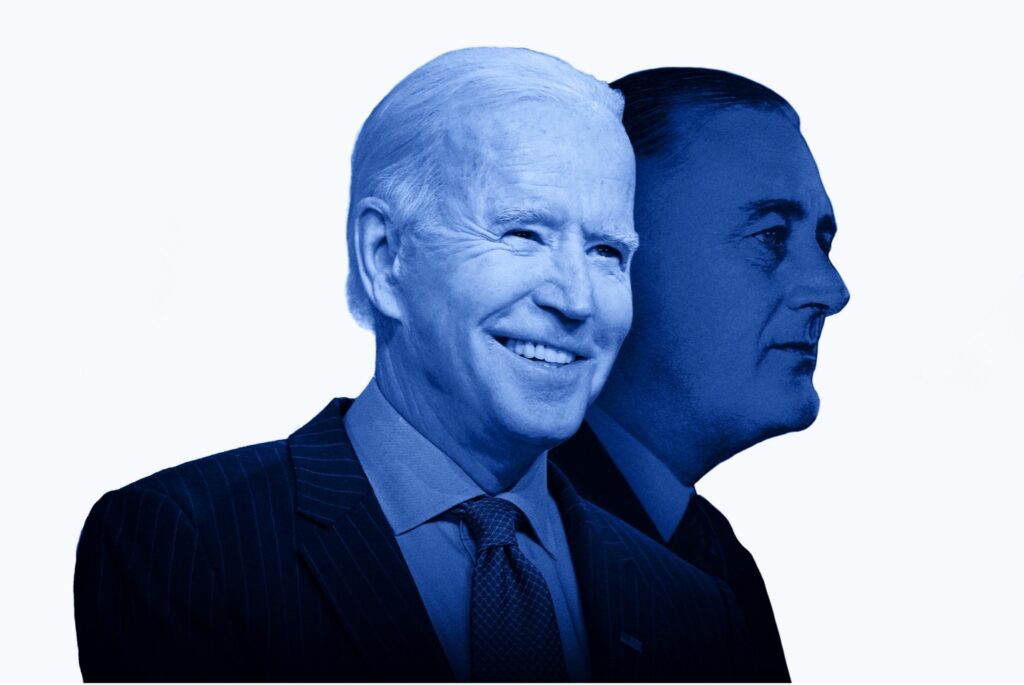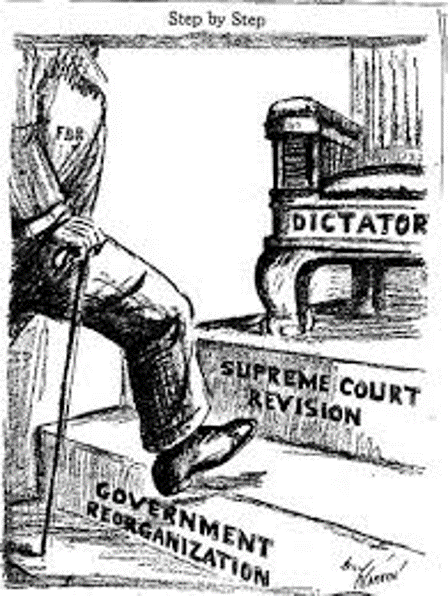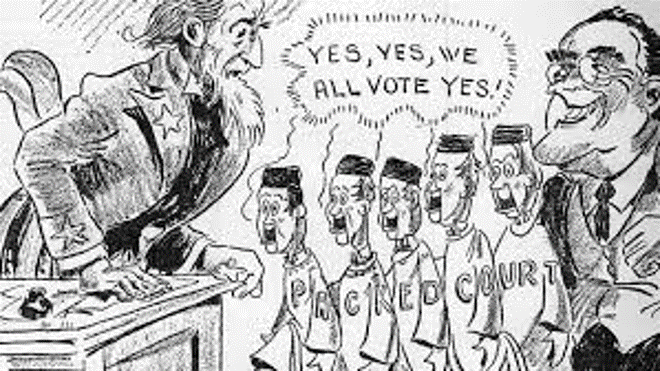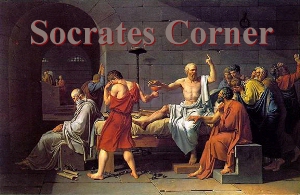What the Failures of FDR’s Court-packing Bill Predict about Biden’s Supreme Court Commission

“If anything would make the Court look partisan, it would be that—one side saying, ‘when we’re in power, we’re going to enlarge the number of judges so we would have more people who would vote the way we want them to”
~ Justice Ruth Bader Ginsburg
The United States Supreme Court has served as a national bastion of judicial excellence and independence since America’s founding. The Court derives its principal authority from Article III of the Constitution, cementing many of the core procedural functions granted to the Court by the 1st Congress in the Judiciary Act of 1789. Upon passing the Act, the Founders established a set number of members—1 Chief Justice and 5 Associate Justices. Congress would later expand the size of the Court to 1 Chief Justice and 8 Associate Justices serving life-time tenures, through the passing of the Judiciary Act of 1869. Despite the long-standing traditions pertaining to the size, composition, and legal authority wielded by the 9 Justices, there have been several notable attempts to alter and expand the number of Justices presiding on the Court.
Such challenges typically arise from Progressive presidential administrations seeking to manipulate the traditional construct of the high Court in order to implement proposed policies into law, or as a direct rebuke to the manner by which a majority contingent of Justices have rendered decisions against the best interests of the executive branch.
History seems to repeat itself at times, with the original arbitrator of the infamous “Court-packing” scheme being none other than Democrat President Franklin D. Roosevelt (1933-45) during the height of the New Deal Era, compared to modern day with another Democrat President, Joe Biden, proposing a similar Court-packing initiative in 2021. Biden’s Supreme Court Commissioncomprises of a team of seemingly bi-partisan experts—former legal practitioners, law professors, and judges—appointed to discuss public views regarding judicial reform proposals. Such topics to be analyzed include, “the genesis of the reform debate; the Court’s role in the Constitutional system; the length of service and turnover of justices on the Court; the membership and size of the Court; and the Court’s case selection”. As of July 20th, the Commission hosted its third official meeting, tasked with providing Biden with a detailed report on proposed suggestions for reforming the U.S. court system as a whole, with special attention on the Supreme Court. Among the many topics discussed, eliminating the option for life-tenure and imposing term-limits for Justices emerged as one of the leading points of discussion during the fourth panel of the meeting.
Conservatives on the six panels comprising the third meeting have warned against the Progressive push to pack the Court beyond the traditional 9 Justices, alleging that it will introduce irreputable damage to the Court’s institutional framework, while nullifying any semblance of independence held by the Judicial Branch. This, while proponents of packing the Court argue that “democracy is under assault” in regards to the current slate of Justices currently serving, and they misleadingly believe that expanding the number of Justices would continue a historical trend of reforming the Court when necessary. In reality, the Supreme Court’s size has undergone very infrequent changes since the American founding, maintaining its current number of Justices for over 150 years since the Judiciary Act of 1869. It also should be well noted that every state’s highest court in America has between five and nine justices. Similarly situated courts in other developed countries like France, our northern neighbor of Canada, and Germany all have nine justices. A departure from this by Biden’s misguided court-packing attempt would betray the traditional construct of the judicial branch.

Many have speculated that Biden’s desire to appoint such a Commission to expand the number of Justices on the Court was politically driven, primarily inspired as a rebuke to President Trump successfully nominating three new Justices during his first term. Biden’s Commission was in fact formed just 6 months after the nomination of Amy Coney Barrett as Associate Justice, which many Congressional Democrats vigorously sought to halt on the argument that the late Ruth Bader Ginsburg’s vacancy should be filled after the victor of the 2020 Presidential Election is named. If true, Biden’s justification for the Commission is not as a means to enact needed judicial reform, but instead to radically expand the traditional size of the Supreme Court in order to cement a liberal majority for generations.
With the above in mind, the grave political interference and threat to the balance of powers presented by the Biden’s administration can be more aptly compared to the original author of Court-packing, FDR. Both FDR’s original mandate and Biden’s current Commission to expand the size of the Supreme Court threaten to erode to the Supreme Court’s long-standing judicial independence as separate from the selective control of the executive branch. FDR’s scheme to pack the Court was originally known as the Judicial Procedures Reform Bill of 1937, a legislative proposal to expand the Court’s size to override the four conservative Justices on the bench, who during that time constantly rejected New Deal legislation as unconstitutional.

The four conservative Justices of the Hughes Court—George Sutherland, James Clark McReynolds, Pierce Butler, and Willis Van Devanter—were instrumental in striking down the majority of New Deal proposals challenged in Court, sparking the infamous title, “The Four Horsemen of the Apocalypse,” as used by the FDR-favored news media back then. In opposition to the conservative wing and in favor of FDR’s mandates were the “Three Musketeers”, the liberal-leaning Justices—Benjamin Cardozo, Harlan Fiske Stone, and Louis Brandeis—while Chief Justice Evan Hughes and Justice Owen Roberts were considered the intermediary swing votes. Justice Stone was infamous for his strict stance against the prevailing brand of Natural Law jurisprudence and anti-New Deal sentiment that occurred during Lochner Era, where the conservative majority overturned various minimum-wage laws, hourly work restrictions, and rights to organize laws under Natural Law or Natural Rights grounds.

One of Justice Stone’s most notable opinions derived from the case of Carolene Products v. U.S. (1938), namely his Footnote Four, which encouraged a more strict level of scrutiny beyond the rational-basis review, implying that Congressional legislation should more strictly be related to and comply with a state’s interests. Contrary to popular belief, this infamous Footnote was actually not written by Justice Stone, but by an obscure law clerk of his, Louis Lusky, who would later provide evidence of him writing the original draft of the note as revealed in his 1993 book, “Our Nine Tribunes: The Supreme Court in Modern America,” according to a 2012 essay by my father, Professor Ellis Washington published in WND.com. Lusky’s secrecy in authoring of this note rendered a significant impact on the Court introducing “strict scrutiny review” to replace rational basis review when pertaining to certain cases before the Court, such as regulatory legislation, leading to the perception of Lusky operating as a “Shadow Justice” with the power to sway the scope of judicial review. The first official use of strict scrutiny review was in the infamous case of Korematsu v. United States (1944), validating FDR’s racist executive order that placed Japanese Americans in internments camps during the Second World War, under the racialist assumption that during wartime the Japanese would side with Japan’s Emperor Hirohito against America.
With the conversion of Justice Roberts to join the liberal-wing of the Court in upholding a Washington state minimum wage law in the case of West Coast Hotel Co. v. Parrish, this sparked “The Switch in Time that Saved Nine”, citing Justice Roberts’s overturning of the Adkins v. Children’s Hospital (1923) precedent and switch to orient his voting pattern with the Three Musketeers just 3 weeks after FDR’s Fireside chat criticism of the Lochner Era Court. The phrase coined by humorist Cal Tinney takes after the witty aphorism of similar name, “a stich in time saves nine”, and means that the preventative work used to avert an incoming disaster [in this case, Justice Roberts’s siding with the liberal-wing to avert the probable enforcement of FDR’s disastrous court packing scheme] is usually less strenuous work than fixing that specific thing after it breaks [i.e., restoring the Court’s judicial independence after FDR increased the number of Progressive Justices].
Many viewed this as Justice Roberts’s fearful acquiescence to the trend of New Deal legislation in order to protect the Supreme Court’s independence from proposed expansion. While expansion was averted, Roberts’s switch marked the end of the Lochner Era and the beginning of more preferential treatment to New Deal legislation. Much to the demise of privatization, no longer would the Supreme Court continually strike down restrictive legislation aimed at regulating business practices. This case also marked a steady decline in the Court’s previous adherence to Natural Law precedent as a means of upholding private companies’ substantive due process rights apart from governmental intrusion. While Chief Justice Hughes denied that President Roosevelt’s Fireside chat held no sway over the perceived shift in jurisprudential voting for the Court following the Parrish case, the delayed announcement of the Court’s decision on March 29th, 1937, grants suspicion to the timing effect and influence of FDR’s March 9th Fireside address.

In closing, the political motivations behind the current Supreme Court Commission should not be overlooked when assessing the historical groundwork laid by FDR’s parallel unsuccessful attempt to pack the Court. The executive branch should abstain from seeking to bend the Supreme Court to its will, which only serves to dilute and tarnish the institutional independence of the federal Judiciary as it falls prey to political indoctrination. The public should be more informed about the veiled intentions behind the Biden administration’s Commission on the Supreme Court, the motivation of which appears to be in retaliation to President Trump’s nomination of three well-qualified Justices, the resulting conservative majority on the bench, and the unhappiness by many Progressives with the trajectory of the Court’s more Constitutionally-sound decision-making.

Question?—Did FDR fail in his attempt to pack the Supreme Court or after a series of public defeats by the Conservative majority that was mysteriously switched beginning in 1937 when SCOTUS started voting pro-New Deal cases brought before the Supreme Court because of FDR’s “threat” to pack the Court? The insertion of the Louis Lusky “Footnote four” in the Carolene Products case of 1938 and the perverse jurisprudence that descended from that ruling beginning with the Korematsu case in 1944 has been upheld by SCOTUS even to this day. In my book makes, this made FDR the winner and constitutional jurisprudence, Natural Law and Natural Rights the loser.
Category: Socrates Corner






